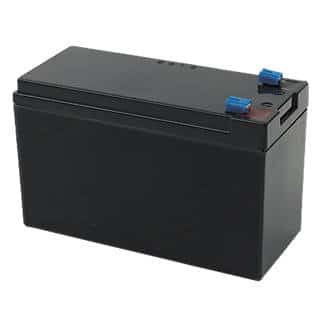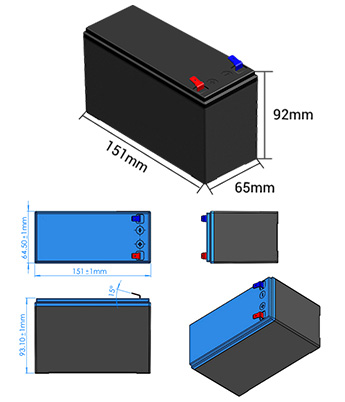How Can LiFePO4 Batteries Be Used To Replace Lead-acid?
Most energy storage systems, like UPS and solar energy storage, use lead-acid batteries, but more and more people are coming to use lithium iron phosphate batteries (LiFePO4) instead.
How does LiFePO4 replace Lead-acid batteries?
LiFePO4 batteries are compatible with lead-acid-battery equipment all the while having a higher discharge platform, volumetric specific capacity, and cycle life.

12.8V 7Ah Lead-acid battery
The nominal voltage of each cell of a lead-acid battery is 2.1V while the LiFePO4 is 3.2V.
To connect cells in series to form a 12V battery pack, lithium iron phosphate only needs 4 cells (3.2V x 4 = 12.8V) compared to the 6 cells of a lead-acid battery (2.1V x 6 = 12.6V). Already based on this knowledge, it is clear that lithium iron phosphate batteries are more advantageous than lead-acid batteries in terms of energy ratio, weight, and volume.

12.8V 7Ah Himax LiFePO4 modular battery
Each LiFePO4 Modular 12.8V battery can be set up in parallel or series in order to meet the needs of your current set up. For example, for a 48V setup, 4 cells of 12V should be hooked up in series. Simply remove the Lead-Acid Batteries and replace them with the Lithium iron phosphate Batteries and attach cables and secure the holding bracket.
Limitation of Lead-acid batteries
The charging efficiency of Lead-acid batteries is relatively low at 70% whereas the charging efficiency of LiFePo4 batteries can exceed 80% or even 90%. A lead-acid battery needs more energy for recharging, so a lot of energy is lost during the charging process.
Some other features of lead-acid batteries are as follows:
- Fast or partial charges ruin a lead-acid battery
- Charging times are long from 6 to 8 hours
- An incorrect charger or setting reduces battery life
- Poor maintenance will also reduce battery life
Other benefits of Lead-acid replacement batteries
Consistent voltage for a longer time
No more flickering lights or spotty performance. Lead-acid batteries can be unreliable for powering accessories at 50% or lower whereas Himax 12.8V LiFePO4 Lead-acid replacement batteries provide a constant output of energy all the way down to as little as 5% of its power.

Fast Charging
Lithium-ion batteries can be “fast” charged to 100% of their capacity. Normally, the LiFePo4 battery can be charged to 50% of its capacity in only 30 minutes. However, the Grepow lithium batteries with fast-charging technology can reach 100% of its capacity within 30 minutes; the maximum charging efficiency can go up to 3C for the charging rate.
Smart and Multi-connected battery
LiFePO4 batteries are equipped with a Battery Management System (BMS) board, and you can check on the State of Charge (SOC). More importantly, the 12.8V modular LiFePo4 battery allows for multiple connections, so you can connect batteries in series and parallel without an external BMS (max 4S10P; the maximum parameter is 51.2V and 70Ah). You can also assemble the battery into different structures and shapes to fit it into the available space of your device.


